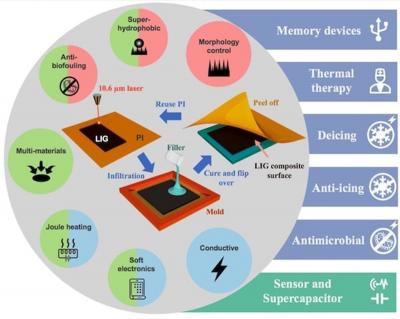The labs of Rice University chemist James Tour and Christopher Arnusch, a professor at Ben-Gurion University of the Negev in Israel, introduced a batch of graphene-enhanced composites that can be a step towards more robust packages.

By infusing laser-induced graphene with plastic, rubber, cement, wax or other materials, the lab made composites with a wide range of possible applications. These new composites could be used in wearable electronics, in heat therapy, in water treatment, in anti-icing and deicing work, in creating antimicrobial surfaces and even in making resistive random-access memory devices.
To make the composites, the researchers poured or hot-pressed a thin layer of the second material over LIG attached to polyimide. When the liquid hardened, they pulled the polyimide away from the back for reuse, leaving the embedded, connected graphene flakes behind.
Soft composites can be used for active electronics in flexible clothing, Tour said, while harder composites make excellent superhydrophobic (water-avoiding) materials. When a voltage is applied, the 20-micron-thick layer of LIG kills bacteria on the surface, making toughened versions of the material suitable for antibacterial applications.
Composites made with liquid additives are best at preserving LIG flakes’ connectivity. In the lab, they heated quickly and reliably when voltage was applied. That should give the material potential use as a deicing or anti-icing coating, as a flexible heating pad for treating injuries or in garments that heat up on demand.
You just pour it in, and now you transfer all the beautiful aspects of LIG into a material that’s highly robust, Tour said.




Laser induced graphene
Some of the inventions coming out of Tours group are real losers. The graphene doesnt stick to the polyimide substrate.
So what use is it. And infusing graphene stuck to a tape with polymer will make inferior quality materials material.